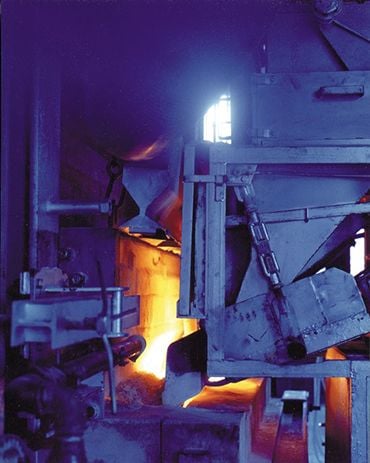Mathematics in the design and manufacture of novel glass products
Equations devised at the University of Oxford underpin modelling software used by market-leading glass companies, helping them to produce flawless products from a substance which is difficult to control.
 Filling machine at Schott AG.
Filling machine at Schott AG.(Image courtesy of Schott AG)
Glass is a substance we take for granted, but the manufacture of glass products is not always a straightforward process. The behaviour of viscous fluids like molten glass is extremely complex, and imperfections such as bubbles in the glass can lead to flaws in the finished product, which may then have to be scrapped.
As a result the glass industry makes extensive use of theoretical modelling to control the costs involved in the design and manufacture of novel glass products, and to reduce the incidence of faults. This is an area in which Peter Howell has two decades of experience, and the mathematical models he has devised are now used by glass companies worldwide.
Howell began by studying the way in which thin sheets and jets of viscous fluid evolve over time, developing simplified models which give a greater insight into possible instabilities in the system, and allow for much more efficient computation. This enables more effective control of glass processes, so that it is possible to produce flawless products with optimised properties and also avoid catastrophic failures at the manufacturing stage.
Bubbles in finished products are a particular problem in glass manufacture. In a glass furnace, many tiny gas bubbles are produced as the raw material melts and reacts. To avoid defects in the finished product, it is essential that all these bubbles are eliminated before the glass leaves the furnace for further processing. Howell developed mathematical models of the drainage of a bubble at the surface of a viscous fluid, generating formulae that determined how long it would take for a given bubble to burst, and incorporating methods that allowed for the influence of impurities on bubble bursting.
Researchers at Oxford developed models to determine how to draw glass tubes that were not cylindrical (e.g. with a square cross-section), and also how to predict the temperature profile required to produce a final desired windscreen shape (heated glass sheets need to sag by exactly the right amount to create the right shape).
Much of this research was conducted in collaboration with the glass industry, and leading international companies such as Schott AG and Pilkington have now incorporated mathematical methods developed at Oxford into the modelling software they use on a day to day basis. All aspects of the research – the methodology for modelling thin viscous sheets and fibres, solutions for drawing non-cylindrical tubes, developing an understanding of defects such as bubbles, and modelling windscreen manufacture – have been applied in practice. The models allow companies to reliably test and optimise manufacturing processes for new products before they are made, thus reducing the amount of experimentation needed in the factory and the incidence of faults in the finished product, and leading to significant savings in terms of time, materials and money. For a company like Schott, with global sales of €2 billion a year, the benefits are very substantial.
Funded by: EU Research Training Network Mathematics for the Glass Industry: Computing and Analysis (MAGICAL)